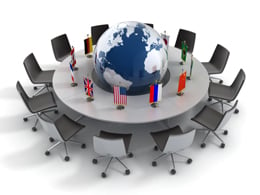 The Trans-Pacific Partnership (TPP) is a major trade agreement among 12 countries, including most of the major economic powers in Asia, along with the U.S.—but notably excluding China. After five years of negotiations, the participating parties reached accord on October 5, and the agreement is now working its way toward approval in the various national legislatures. But is the TPP a good idea?
The Trans-Pacific Partnership (TPP) is a major trade agreement among 12 countries, including most of the major economic powers in Asia, along with the U.S.—but notably excluding China. After five years of negotiations, the participating parties reached accord on October 5, and the agreement is now working its way toward approval in the various national legislatures. But is the TPP a good idea?
The approval process
In June, President Obama won trade promotion authority for the agreement. Popularly known as fast-track status, this requires Congress to either approve or deny the agreement as is—that is, without amendments or changes. Even so, approval here in the U.S. is still likely to be fraught with challenges, insofar as the agreement has been caught up in politics.
Hillary Clinton, who helped negotiate the TPP and who at one point referred to it as the “gold standard” of trade agreements, has announced that she opposes it, a position in line with most of the Democrats in Congress. Even Senate Majority Leader Mitch McConnell, a Republican, has noted that there are “a number of troubling parts to the agreement,” which is noteworthy, as his party has historically been in favor of free-trade agreements. Approval, while likely, is far from guaranteed.
Should we care if the TPP gets approved?
Yes, in fact, we should. The TPP is worth approving—and not just for economic reasons.
The economic reasons are important. Tariffs (fees charged on imports) will be lowered across the board. More important, less formal trade barriers—environmental and labor standards, for example—will be harmonized, and other requirements specific to service industries, where the U.S. has a competitive advantage, will come down. This will be positive for the U.S., although in truth, U.S. exports to all of these countries combined are simply not big enough to move the needle here. It will be helpful, but not a big deal. Although the economic reasons are good, they are not the primary reason the agreement should be approved.
But the primary reasons the TPP is important are geopolitical. The benefits of this agreement for other countries will be much more substantial than those for the U.S. All of the countries included depend much more on trade than the U.S.—and specifically on access to the U.S. market. By opening further, we can help their economies stabilize and grow. In a troubled time, with many emerging markets struggling to deal with the decline in Chinese commodities demand, this is a real helping hand and can potentially avert economic turbulence that could hurt the U.S. For all the talk of the weakness of emerging markets, and rising economic risks, this is a measure that would help mitigate those risks.
There are other benefits as well. By strengthening the economies of these countries, we also make them less susceptible to pressure from China—and more likely to support the U.S. This matters, as Asia right now is in much the same position as post-WWII Europe was. With China rising, just as the Soviet Union was, and surrounded by smaller countries that can’t resist individually, those countries either have to accommodate that rise or get help from somewhere else. In Europe, the Marshall Plan provided just that support.
Asian countries don’t need a post-war rebuild, of course, so the parallel is not exact, but an underappreciated part of the Marshall Plan was that it allowed the western European countries open-trade access to the U.S. That is what allowed them to continue to grow and resist the Soviet Union for decades, and that is part of what is potentially at stake with the TPP. Providing open-trade access to the U.S. can strengthen the small Asian countries and help them resist China in exactly the same way we helped European countries resist the Soviet Union. At the same time, of course, we can reap economic benefits. Nice to do well by doing good.
This is not an anti-China move, either, but a pro-small country move. In theory, China could choose to join, just as the Warsaw Pact countries could have done. If China is not committed to confrontation, it might even do so—to everyone’s benefit. If not, the benefits still apply.
The Marshall Plan was initially conceived as a plan for resisting the Soviet Union, and only over decades did its ability to foster growth and independent powers become apparent. The TPP reverses that causality—it starts with economics—but the effects over time will be similar. An agreement that benefits the U.S. in multiple ways, by helping other countries both economically and politically, is worth supporting in our own best interests.


 Print
Print


